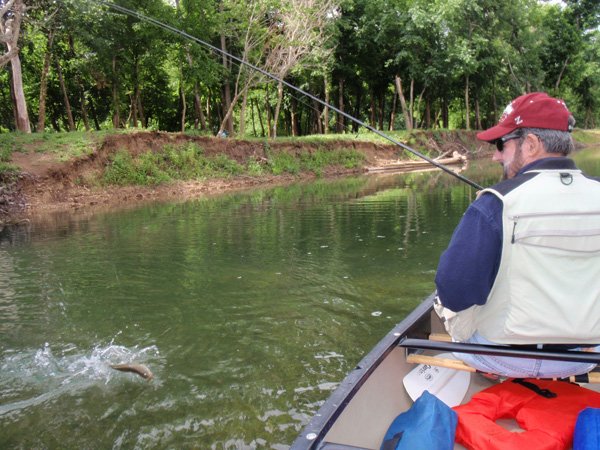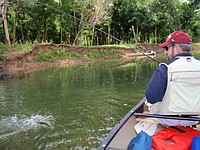SPINEVILLE, Mo. — Editor’s Note: This week and next, Outdoors will visit two of southwest Missouri’s top streams for floating and fishing. Today we visit the Elk River.
Next Thursday we’ll float-fish Indian Creek, a tributary of the Elk.
Many canoes, kayaks and inner tubes clog the Elk River on summer weekends that a clown on a pogo stick could hop from boat to boat and never touch water.
Rivercraft and revelers, thousands of them, boggle the mind.
On weekdays, the Elk is a quiet fisherman’s stream. Monday through Friday sounds might include a kingfisher’s cackle or the splash of a leaping smallmouth bass.
Boom boxes and ice chests are standard gear for the weekend crowd. A fishing pole and lunch suits anglers who can float the Elk during the week. They might not see a soul.
That’s how Russ Tonkinson of Rogers and I found the Elk River when we hopped into a canoe on June 1, a weather-perfect Friday.
Our float covered about seven miles of river from Big Elk Camp near Pineville, Mo., to our take-out at Shady Beach.
We checked in at Big Elk Camp to secure a boat from owner John Tinsley and pick his brain for thelatest fishing tip. The weather was ideal, but the river was low as it has been for most of the spring.
“There’s been enough water,” he said. “It’s been good fishing on and off. It’s a lot better than it was last year with the high water. This year we could use a mini-fl ood,” he said.
Low water was fine with us.
Getting out to walk the canoe is a chance to stretch stiff legs and wade-fish prime spots.
Photo Gallery
Floating the Elk River
Russ Tonkinson of Rogers and NWA Media outdoors writer Flip Putthoff found out first-hand on June 1 why the Elk River is one of the Ozarks' top streams to float and fish for smallmouth bass. Clear water, abundant cover and lots of food combine for superb habitat on the southwest Missouri stream. The two anglers always secure a little fish karma by picking up litter before starting a float trip. Photos by Flip Putthoff
CLEANUP CREW
Our river trips include a ritual that’s become almost religion. At the put-in, we pick up any litter to increase our karma with the fish.
It works. We’ve enjoyed some great fishing and are glad to leave a place nicer than when we arrived.
The beach at Big Elk Camp was clean as a whistle. No litter, no karma. It didn’t matter. We caught one smallmouth bass and an Ozark bass five minutes into the float.
Smallmouths seemed eager to bite Tonkinson’s soft-plastic crawdad. Tube baits got the same bass attack. These, too, imitate crawdads.
With each paddle stroke, it became clearer that fi sh were holding in deep water. If a section wasn’t at least a foot deep, we’d drift over it. Now and then we’d get pedestrian and walk the canoe over thin water.
So transparent is the Elk River that it’s easy to see smallmouth bass cruising the deep holes. Tonkinson felt a peck on his craw lure and reared back.
“There he is, right where he should be,” Tonkinson hollered. That would be deep water, a hole about 4 feet deep.
Clear water means downsizing lures. Nothing we used was more than 3 inches long. Six-pound test is standard line for the Elk and most Ozark streams. Small lures and light line worked this day on the Elk.
BANNER STREAM
On Tuesday, I checked in with Rick Horton, a fi sheries management biologist with the Missouri Department of Conservation, for his annual “State of the Fish” report from the Elk River.
The Elk is among the best for smallmouth bass in Missouri and it still is, Horton confi rmed.
“We do our surveys in the fall. Last year we had similar results to what we’ve gotten in the past. Our catch rates are around 100 black bass per hour. That’s very good for a stream system,” Horton said.
Crews survey the stream by electrofi shing.
Smallmouths of 8- to 12-inches make up the bulk of the population. Good numbers of larger fish swim in the river.
“From Noel upstream, it’s primarily smallmouth bass. Downstream from Noel, you get spotted bass in the mix.”
The granddaddy of all bass was a 22-inch largemouth bass caught and released during the survey. Horton fi gures it weighed 8 pounds.
“That’s huge for a stream largemouth,” he said.
Anglers may catch all three black bass species - smallmouth, largemouth and spotted bass - in the Elk. The habitat is excellent. There’s clean water, cover and food.
Horton said the lower miles of river below Noel have some big catfish. Work the deep holes and deep water around root wads for catfi sh, Horton advised.
PICKING UP
Fishing was good, but we got even more excited when Tonkinson spied a scene along the bank.
“Hey. There’s some litter. We can pick up some more karma.”
Our canoe hit the beach. Out came the mesh trash bag that’s issued to each Elk Riverboat renter. We filled ours to bursting, then reaped the fruits of our toil and caught more fi sh.
By trip’s end at Shady Beach, we’d caught and released 40 to 50, mainly smallmouth bass and Ozark bass.
The daily limit for keeping smallmouths is two fish per day that are 15 inches or longer.
Karma came through, all right, though big fish avoided us. Our largest smallmouth was maybe 13 inches. We gotplenty in that 8-12-inch range that Horton mentioned.
Next trip we’ll take two trash bags and catch Mr. Big.
Outdoor, Pages 6 on 06/28/2012


